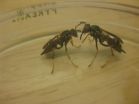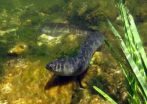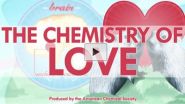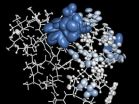(Press-News.org) BOSTON (Feb. 10, 2014)—Reinforcing the need to look beyond genomic alterations to understand the complexity of cancer, researchers from Dana-Farber/Boston Children's Cancer and Blood Disorders Center report that a normal enzyme called SYK pairs with FLT3, the most commonly mutated enzyme found in acute myelogenous leukemia (AML), to promote progression of the disease. This molecular partnership also promotes AML cells' resistance to treatment with FLT3-blocking drugs, potentially explaining the relatively poor showing of FLT3 inhibitors in multiple clinical studies. In an animal model of AML, treatment with a combination of FLT3- and SYK-inhibiting drugs was significantly more effective than treatment with either drug alone.
The findings, published Feb. 10 in the journal Cancer Cell, raise hopes that treatment strategies that focus on both enzymes simultaneously could help bring molecularly targeted treatments to AML, a common blood cancer. The study also may have broader implications for how clinicians approach the development of such treatments and understand mechanisms behind resistance to treatment in other cancers.
Approximately 14,600 Americans are expected to be diagnosed with AML this year; children account for about 18 percent of patients. The overall outlook for AML patients is mixed; while the majority of patients with AML achieve remission with treatment, many relapse. The cancer cells of some 20 percent of adult and 15 percent of childhood AML patients harbor a genomic alteration called FLT3-ITD, in which segments of the FLT3 enzyme are duplicated again and again, making the enzyme overactive.
"Patients whose AML cells express FLT3-ITD are among the highest risk group of patients with AML," says the study's senior author, Kimberly Stegmaier, MD, of Dana-Farber/Boston Children's Hematologic Malignancies Center. "Their AML is particularly difficult to treat."
FLT3 is a kinase, a molecular switch that routs signals for growth, division and other processes within cells. Many cancers harbor mutations or other alterations that leave kinases stuck in the "on" position. This knowledge laid the foundation for the targeted cancer treatment revolution inaugurated by imatinib (Gleevec®), which has made another blood cancer, chronic myelogenous leukemia, a controllable, chronic disease for many patients.
However, patients with AML have not yet benefitted from that revolution. Researchers and pharmaceutical companies are actively working on FLT3 inhibitors, but to date these efforts have been hampered by low efficacy and concerns about drug resistance.
In 2009, Stegmaier's laboratory discovered that SYK, a kinase that had attracted attention for its role in other malignancies, could be a potential drug target in AML. Unlike other cancer-associated kinases, SYK rarely undergoes mutations or other genomic alterations in cancer cells, remaining in its normal or "wild-type" form.
To better understand SYK's role in AML, in the current study, Stegmaier, lead author Alexandre Puissant, PhD, of Dana-Farber/Boston Children's, and their collaborators screened AML cell lines to reveal the full scope of the enzyme's molecular interactions. They found evidence of strong interactions between wild-type SYK and mutated FLT3, in particular FLT3-ITD.
"We wanted to understand the cooperative oncologic effects by which SYK contributes to AML," Stegmaier explains. "The concept of a normal enzyme aiding a mutant one has not yet been widely explored, and so we were both surprised and pleased to see FLT3-ITD come up as a high-priority hit in our screens."
Through experiments in cell lines, primary patient samples and animal models, the research team found that SYK and FLT3-ITD's interactions are a key ingredient in the progression of myeloproliferative disorder, a related blood cell disorder, into AML. AML cells' continued growth after turning malignant also relied on these interactions.
Additionally, the team found that SYK's hyperactivated form can promote resistance to the FLT3-targeting drug quizartinib (AC220, Ambit Biosciences). They could overcome this resistance with a combination of quizartinib and the SYK-blocking molecule PRT062607 (Portola Pharmaceuticals), significantly increasing survival and reducing signs of disease in an FLT3-ITD AML mouse model.
Highlighting their findings' clinical relevance, the researchers found strong SYK activity in cells from FLT3-ITD AML patients. The cells were also highly sensitive to SYK inhibition.
"These data affirm that SYK is an important target in AML," Stegmaier states. "They also suggest that interactions between oncologic kinases and SYK or other wild type enzymes may contribute to resistance of kinase inhibitors more broadly."
Stegmaier notes that over the course of this research, the team has developed a suite of tools that could prove invaluable for future clinical studies of treatments with SYK inhibitors or SYK inhibitors in combination with FLT3 inhibitors.
"We have not only identified SYK as a candidate treatment target in AML, but we have also identified a specific population of patients with AML more likely to respond to SYK inhibitors: patients with FLT3 mutations," she says. "Moreover, we have developed tools for identifying patients with high levels of SYK and FLT3 activation and can monitor these two targets while patients are receiving treatment. Predictive biomarkers of response are becoming increasingly important in the development of effective clinical trials of targeted therapies."
INFORMATION:
The study was supported by the National Cancer Institute (grant number R01CA140292), the American Cancer Society, the Starr Cancer Consortium, Project Cupid and One Mission, the Swedish Research Council and Swedish Cancer Society and the Leukemia and Lymphoma Society.
The Dana-Farber/Boston Children's Cancer and Blood Disorders Center brings together two internationally known research and teaching institutions that have provided comprehensive care for pediatric oncology and hematology patients since 1947. The Harvard Medical School affiliates share a clinical staff that delivers inpatient care at Boston Children's Hospital and outpatient care at the Dana-Farber Cancer Institute's Jimmy Fund Clinic. Dana-Farber/Boston Children's brings the results of its pioneering research and clinical trials to patients' bedsides through five clinical centers: the Blood Disorders Center, the Brain Tumor Center, the Hematologic Malignancies Center, the Solid Tumors Center, and the Stem Cell Transplant Center.
Normal enzyme aids a mutant 1 to fuel blood cancer's growth
The combination of these enzymes also linked to resistance to treatment
2014-02-10
ELSE PRESS RELEASES FROM THIS DATE:
Flat-pack lens boosts solar power
2014-02-10
Micro-machining could be used to create almost flat, Fresnel lenses, that boost the electrical efficiency of solar panels, according to researchers in China.
Fresnel lenses were invented by French engineer and scientist Augustin-Jean Fresnel, in the early nineteenth century, they are essential two-dimensional equivalents of conventional optical lens, but they have ridges in concentric rings that focus the light to a point behind the lens without the three-dimensional bulk of a conventional lens. Image quality is reduced when using a Fresnel lens to focus because the concentric ...
Study reveals unexpected cell hijack method in pancreatic cancer
2014-02-10
Pancreatic stellate cells, which normally aid tissue repair, unwittingly help pancreatic cancer grow and spread in a method of 'cell hijack' only seen before in brain and breast cancer, according to new research from Queen Mary University of London.
The research, published in the latest issue of EMBO Molecular Medicine and carried out by Queen Mary's Barts Cancer Institute, also revealed the process can be blocked, thereby preventing the growth and spread of the tumour.
The study, funded by the UK charity Pancreatic Cancer Research Fund, set out to investigate the messaging ...
EORTC characterizes responders & survivors on pazopanib for advanced soft tissue sarcoma
2014-02-10
An EORTC analysis appearing in Annals of Oncology confirmed the importance of known prognostic factors such as performance status and tumor grading for having a long-term outcome in patients treated with pazopanib for metastatic soft tissue sarcoma. Additionally, hemoglobin at baseline was found to be a new prognostic factor.
Soft tissue sarcomas are a heterogeneous and relatively rare tumor with an estimated incidence of four per 100,000 people per year in Europe. The prognosis for patients with this disease is favorable if they are diagnosed at an early stage and if ...
Massive neutrinos solve a cosmological conundrum
2014-02-10
Scientists have solved a major problem with the current standard model of cosmology identified by combining results from the Planck spacecraft and measurements of gravitational lensing in order to deduce the mass of ghostly sub-atomic particles called neutrinos.
The team, from the universities of Manchester and Nottingham, used observations of the Big Bang and the curvature of space-time to accurately measure the mass of these elementary particles for the first time.
The recent Planck spacecraft observations of the Cosmic Microwave Background (CMB) – the fading glow ...
Wasps use ancient aggression genes to create social groups
2014-02-10
Aggression-causing genes appeared early in animal evolution and have maintained their roles for millions of years and across many species, even though animal aggression today varies widely from territorial fighting to setting up social hierarchies, according to researchers from Iowa State University, Penn State and Grand Valley State University.
If these "mean genes" keep their roles in different animals and in different contexts, then perhaps model organisms -- such as bees and mice -- can provide insights into the biological basis of aggression in all animals, including ...
Dental care in school breaks down social inequalities
2014-02-10
A new survey conducted by the University of Copenhagen and the World Health Organization (WHO) is highlighting the role of schools in work to promote health and prevent disease.
"Children in Scandinavia generally have healthy teeth and gums, largely on account of dental care in schools for all children, the arrival of fluoride toothpaste on the market, a healthy lifestyle and high living standards. But the situation in the poorest countries of the world is very different to that in Scandinavia. However, it is positive to note that the WHO's Health Promoting Schools Initiative ...
Threatened eels disappear in the deep on their way to the Sargasso Sea
2014-02-10
When the threatened European eels cross the Atlantic Ocean to get to the Sargasso Sea to spawn, they swim in deep water. But this does not protect them from predators, researchers from the University of Southern Denmark report: Even in deep water the eels are hunted and eaten.
The European eel is in decline, and all over the world biologists are struggling to map its mysterious life cycle in order to bring its numbers back up. One of the great puzzles is why and how the eel each year travels thousands of kilometers to get to the Sargasso Sea to spawn.
A European monitoring ...
The chemistry of love: Valentine's Day science from ACS Reactions
2014-02-10
WASHINGTON, Feb. 10, 2014 — Love has inspired timeless songs and sonnets — not to mention a few less-than-timeless romantic comedies. Now the chemistry of love is the subject of the latest episode of the American Chemical Society's Reactions YouTube series (formerly Bytesize Science). Just in time for Valentine's Day, the video is available at http://youtu.be/bp7Ydv5wAPk.
The video explains how feel-good neurotransmitters like dopamine and oxytocin fuel lifelong pair bonds in prairie voles, which — along with humans — are the mammalian kingdom's leading monogamists. "If ...
Sometimes the average just isn't good enough
2014-02-10
This news release is available in German. When averaging is good and when it's not
Usually averaging is a good thing that can make life a lot easier. For example, when you eat out with a group of friends and it comes to paying. If everyone had a meal and a drink and you split the bill total by the number of people, everyone will pay pretty close to what they would have paid for their individual meal and drink. However, if some people had a starter, a steak for main, a dessert and champagne while you had spaghetti and a soft drink, you will feel pretty much ripped ...
Oil composition boost makes hemp a cooking contender
2014-02-10
Scientists at the University of York today report the development of hemp plants with a dramatically increased content of oleic acid. The new oil profile results in an attractive cooking oil that is similar to olive oil in terms of fatty acid content having a much longer shelf life as well as greater heat tolerance and potentially more industrial applications.
Researchers in the Centre for Novel Agricultural Products (CNAP) in the Department of Biology at York say that high oleic acid varieties are a major step towards developing hemp as a commercially attractive break ...
LAST 30 PRESS RELEASES:
Making lighter work of calculating fluid and heat flow
Normalizing blood sugar can halve heart attack risk
Lowering blood sugar cuts heart attack risk in people with prediabetes
Study links genetic variants to risk of blinding eye disease in premature infants
Non-opioid ‘pain sponge’ therapy halts cartilage degeneration and relieves chronic pain
AI can pick up cultural values by mimicking how kids learn
China’s ecological redlines offer fast track to 30 x 30 global conservation goal
Invisible indoor threats: emerging household contaminants and their growing risks to human health
Adding antibody treatment to chemo boosts outcomes for children with rare cancer
Germline pathogenic variants among women without a history of breast cancer
Tanning beds triple melanoma risk, potentially causing broad DNA damage
Unique bond identified as key to viral infection speed
Indoor tanning makes youthful skin much older on a genetic level
Mouse model sheds new light on the causes and potential solutions to human GI problems linked to muscular dystrophy
The Journal of Nuclear Medicine ahead-of-print tip sheet: December 12, 2025
Smarter tools for peering into the microscopic world
Applications open for funding to conduct research in the Kinsey Institute archives
Global measure underestimates the severity of food insecurity
Child survivors of critical illness are missing out on timely follow up care
Risk-based vs annual breast cancer screening / the WISDOM randomized clinical trial
University of Toronto launches Electric Vehicle Innovation Ontario to accelerate advanced EV technologies and build Canada’s innovation advantage
Early relapse predicts poor outcomes in aggressive blood cancer
American College of Lifestyle Medicine applauds two CMS models aligned with lifestyle medicine practice and reimbursement
Clinical trial finds cannabis use not a barrier to quitting nicotine vaping
Supplemental nutrition assistance program policies and food insecurity
Switching immune cells to “night mode” could limit damage after a heart attack, study suggests
URI-based Global RIghts Project report spotlights continued troubling trends in worldwide inhumane treatment
Neutrophils are less aggressive at night, explaining why nighttime heart attacks cause less damage than daytime events
Menopausal hormone therapy may not pose breast cancer risk for women with BRCA mutations
Mobile health tool may improve quality of life for adolescent and young adult breast cancer survivors
[Press-News.org] Normal enzyme aids a mutant 1 to fuel blood cancer's growthThe combination of these enzymes also linked to resistance to treatment




